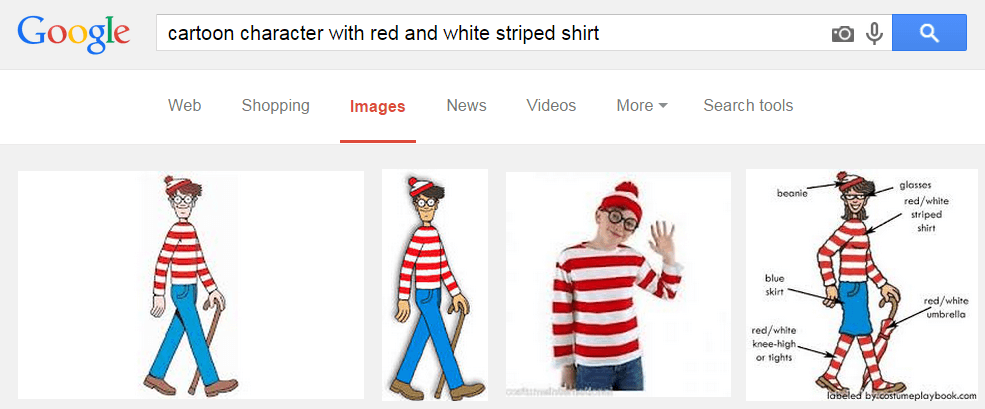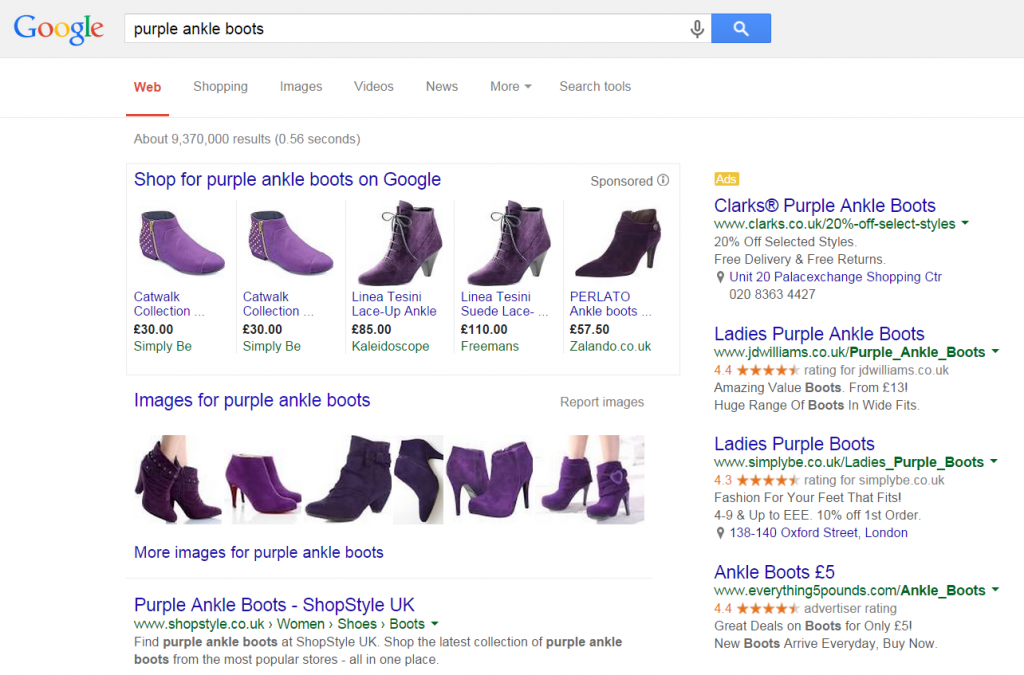So you’ve heard SEO is dead. You believed it because the internet said so. Your friend’s neighbour’s son, who designs websites in his underpants while listening to Slayer, told you. Yup. So you’re aware that a highly creative entrepreneurial team of fwuffy manga-eyed kittens with sticky-out tongues run YouTube?
STOP IT.
Just. Think. Differently.
Question everything. EVERYTHING.
Then question it some more.
This in-depth article is not going to tell you how to do SEO. Get a coffee. It’s more of a detailed and entertaining insight as to where SEO fits within your marketing strategy.
Google Makes Us Smarter
Google has changed the way we live – for better, for worse, in sickness and in health. A few words typed into that sexy magic search box of loveliness will buy me a pizza in 2.39 minutes. It’ll take me straight into the homes of the rich and famous, tell me who you used to work for (poor love, somebody had to) and track down one of those twisty metal thingamabobs to fix my doodah, so I don’t have to take it to the doodah repair shop where my ex-boyfriend works.
As the internet becomes more crowded, we learn to adapt the way we ask for things on Google – we have to be cleverer to find that needle in a haystack, which means marketers have to be even cleverererer in luring us to their pages.
So, you’re probably wondering Where is Wally? (or Where’s Waldo, if you say tomayto). We could play the game, squinting and scanning the cartoony crowd scenes to look for him. But if (for the metaphoric purposes of SEO education) our Wally was a product, and we had but a few seconds to find him, we could be stealthy and type in the key facts we know:

Google Instant (predictive search) already knew what we wanted from the first few words we typed and it prompts us to complete the rest:

How? Because plenty of people already searched for this before, and Google learns like Einstein on steroids. Some of those searchers didn’t know our boy was called Wally, however, they could describe him.
Google makes us smarter.
When people get smarter, search has to get smarter.
Et voilà! Search marketing has to get smarter.
The Psychology and Evolution of Search
We now search very differently than we did just a few years ago and the search engine algorithms are forever evolving to accommodate colloquialisms, new brands and products, mobile usage and chronically busy people. Search results now give us images, videos, news, tips, definitions, conversion tools, weather, flight times, directions, as well as web pages. And a meme for every occasion.
There’s even memes for “a meme for every occasion”. I checked. All in the name of research. Awww doggie on roller skates! *right click, save image as… Pictures > Memes > All Occasions*
So, why do we use search engines?
- we have a question we need answering
- to research information
- we want to buy something
- we want to compare things
- we need our daily dose of distraction, watching the worldwide web’s most popular, peculiar pets
Understanding why someone would find your website, helps you to work out how to better target them. The search engine results pages (known as SERPS) provide the searcher with a list of possible solutions to their problem. It’s up to us, as business owners and marketing professionals, to guide people to click our listing and then engage them with great content. If they don’t find what they want quickly, they be gone. Faster than you can say ‘Google Analytics Custom Campaign Dashboard’.
The 3 main types of search query
We search Google (or any other search engine) in three main ways:
Navigational search queries
This type of search query is used to find a website when we don’t know its actual URL (web address):
- youtube
- jenny’s hair salon
Informational search queries
This type of search query is used to answer a question or research a subject:
- how do i backup my iphone
- what should i do if i smell gas
- is the sky really blue
Transactional search queries
This type of search query is used to find a product or service we want to purchase, and shows customer “intent”
- buy cheap windows 8 laptop
- pizza delivery near me open late
- purple ankle boots

Oooh look! Google gave me exactly what I asked for – purple ankle boots – and I didn’t have to go into real shops where annoying humans hang out, touching everything *ewww germs* or browse through Amazon and eBay to ensure my matchy-matchy boots are complemented by the purchase of a GreenGoop juicer, Supermicrocollagen Spacedust moisturiser, a 28 port USB hub and a 3kg catering size pack of M&Ms.
You know you’ve been there.
How Bounce Rates Affect SEO & Google Rankings
By presenting me with a concise answer to my query for ‘purple boots’, I clicked through to a landing page which was highly relevant to purple boots and I bought them. If the page had shown me purple shoes or pink boots, I may have jumped ship – unsatisfied, unfulfilled (and £85 richer). Abandoning a page in order to seek an answer elsewhere registers as a “bounce” in your Google Analytics. Bounces are (generally) implying your website’s a bit naff or your marketing skill is, well, lacklustre.
High bounce rates can be bad for SEO as they (generally) mean you failed to provide a solution to your customer; Google uses bounce rate as an important metric and one of the many signs that your page isn’t full of the yummy goodness it expects.
It’s a bit like a swipe left on Tinder. Reeeejection.
Continuing the dating site analogy (bear with me on this one) if you’ve been rejected by most people who visit your profile, you can bet your life you’re either:
- pig ugly
- not showing your goods clearly enough
- boring
- apathetic
- intense
- linguistically primitive, or
- giving it too much attitude (anger, resentment, duckface…)
Think websites, engaging content and bounce rates here; don’t get all hatey on me. Pig ugly duckfaces suit some people.
To summarise:
High bounce rate – 70% upwards – people are a bit bummed out with your stuff.
Low bounce rate – 40% or lower – looking fine as wine in the summertime.
Excellent bounce rate – 20% or lower – you’ve pulled. I’m all yours.
There are a lot of factors to consider in analysing bounce rates (industry, type of content, brand) and sometimes a high bounce may mean your customer had their thirst quenched super quick, so didn’t need to look around the site. Topic for another day methinks. The above numbers are just a guide – an “ish”, if you will.
So, What is SEO?
Maybe you’ve tried to SEO your website to the max? And failed. Like a boss.
Maybe you’re still wondering:
- what does SEO stand for?
- what does SEO involve?
- how to do SEO on WordPress
^ See what I did there? *exaggerated wink*. Informational searches, plopped in front of your very eyeballs with the grace and agility of Ninja Cat. Smoooooth.
SEO – Search Engine Optimisation – is the art of:
helping Google*
to help your customers
to find your website
and pick you over someone else.
Now that wasn’t so hard, was it?
*other search engines are available, but we don’t really care too much about Wahoo, Bingbong, Arks and – 2 secs – lemme Google the others.
But There’s Tools & Plugins for SEO, Right?
SEO jargon can be confusing. There are WordPress plugins like Yoast WordPress SEO or All in One SEO (and many others) which offer you all the right little boxes to merrily go adding your SEO “stuff”.
Ooooh look! It’s turned green! I’m an SEO ninja goddess.
Let’s go whacking some more “stuff” into the other boxes and I’ll be page 1 for cheap laptops by next Tuesday.
You’ve noticed there’s an abundance of free online SEO tutorials, website optimisation software, link builders, link checkers, blah, blah and whatnots. So do you know what “stuff” to put in them? Do you understand what “stuff” to recognise when the tools spew out their report cards and technical commentary? Stop fiddling. Put your hands on your head and sit in the naughty corner.
You have to first understand why you’re doing SEO.
Read that bit again. Now tell me I’m a genius.
The Slow & Steady Approach to Online Marketing
I learned the slow and steady way: poking about in web code, tweaking page titles and headings to see what worked, writing and rewriting content, monitoring Google Analytics like a little baby hawklet – anticipating that upward slant on the graph as if my growing wings and hungry belly depended on it. Waiting for the customers to say the magic words “yes, I found you on Google” so I could run around the office excitedly flapping my fluffy bits to remind the boss what a sound investment he’d made by hiring me.
I honed my technical and marketing skills gradually, by applying a few changes at a time, learning HTML code properly and understanding the impact of SEO on business. When da bossman is freakin’ out because the phones are ringing too much and you don’t have enough staff to cope with the increased level of enquiries, you know you’re doing something right. And then – after apologising for seemingly making the business so damn successful – you gather and analyse data to work out which of those enquiries are from customers you truly want and which, if any, are just time-wasting nonsense. Less than 5% in the latter category, go meeee!
So grab a coffee, review your Analytics reports, review that spreadsheet you were using to record the leads coming in by phone (you were keeping records, right?) review your contact form enquiries, tweak your strategy, tweak your keywords, tweak your copy, tweak your sales message. Tweaky tweak tweak.
How to Use SEO for Business
By the time I started to learn SEO for my job at a local estate agents in 2008 (which began along the lines of: You do computers, can you have a look at our website? Erm, I don’t really do websites. You do now) I’d already ‘enjoyed’ a strong commercial and technical career in project management, service improvement, technical support, writing documentation and user guides, and watching users interact with new software they hated.
I was passionately nerdy about huge sets of data and Excel pivot tables; immersing yourself in statistics will enable you to see patterns, trends and not get your knickers in a twist when there’s a minor peak or trough (!important). Wait it out: it could be a seasonal blip or an error with your tool. You fired him already?! Oh lordy, lordy.
Commercial experience and insight into other’s people’s businesses helped me see the bigger picture of how user experience, layout, design and interaction affects our enjoyment of, and efficiency in, using a website. The hordes of free SEO video tutorials I devoured daily, learning about code quality, and watching Matt Cutts in bed at 3am while munching Doritos (he was the guru of search quality in Googleland for 14 years) was invaluable.
I realised that the technical side of SEO and web design, which includes:
| SEO & Technical Jargon | Plain English |
|---|---|
| h1, h2, h3 … h6 headings | Main topics and subtopics on the page |
| page titles | What the page is actually about What it will save as, if I bookmark it |
| meta descriptions | What you’re selling (product/service) Why I would want one (features/benefits) Why you’re different from your competitors Why should I believe your expertise? How can I buy one? |
| alt text | What does the photo/image/graphic actually represent? If I was partially sighted and needed Google to speak the picture to me, what would it say? |
| anchor text | If I click this link, which topic or page are you going to send me to? Will it do what it says on the tin? ‘Click here’ gives no context. |
| robots.txt | A file which sits outside of the main website content to give directions and orders. Sorry spammy search engine, you ain’t welcome on my site! And here’s where the rest of you search engines will find a list of all my web pages, in google readable format |
| sitemap.xml | Here is the list of web pages in google readable format |
| inbound links | Who/what loves your content enough to link to it? |
| outbound links | Which resources do you love and want to share with your audience? |
| navigation | How are you going to help me find the content and get around the site |
… has to be used, cautiously and cleverly, to achieve the business side:
| Marketing Jargon | Plain English |
|---|---|
| visibility | Being found in search results |
| targeting and inviting | Luring searchers with titbits so they click your listing instead of your competitors’ |
| engaging and inspiring | Providing content users want to read and come back for |
| demonstrating | Showcasing products and services |
| lead generation | Generating enquiries and interest in your products & services |
| lead capture | Recording interest from visitors via contact forms or mailing list sign ups |
| selling | Convincing potential customers of the features and benefits |
| cross selling | People who bought this, also consider this |
| up-selling | Selling them more than they came for. Would you like fries with that? |
| brand awareness | Building a reputation based on your unique selling points |
| call to action | Telling them to call you, buy one, sign up or book an appointment |
Aha! Light-bulb moment. Ting! Are you with me now?
How Much SEO is Too Much SEO?
Old school SEO, old fashioned SEO and obsolete SEO from the past was never solely and exclusively about stuffing a massive, humongous, big list of keywords, key phrases and search terms into certain places, positions and locations on your website and hoping for the best, unparalleled, optimum results – despite what people think, believe or surmise.
Yuckkkkk. I think you get the point.
Bad SEO Techniques Can Be Dangerous
You don’t need a page for every town in the UK that you want to cover (Michael). You don’t need to regurgitate every product from the manufacturer’s catalogue without putting your own perspective on it (Jenny). You don’t need to market yourself as a “Web Designer London | We Design Websites London | London Web Design” (Stephen). Ok. I made that one up.
And you absolutely don’t need to be greedy and try to optimise your site for “Best Opticians in the World” #truestory because, I mean, who’s gonna travel the globe for an eye test?!
Who, What, Where, Why, When, How
Whether you’re writing page titles for SEO, correctly naming and tagging your images, or considering writing content for a small business website

always remind yourself:
Who – are my customers, who do I want (and not want) to supply?
What – am I selling, what does it do?
Where – will they search for it, where will they use it?
Why – should they buy one, why am I best suited to meet their needs?
When – are they likely to want it, when could they use it?
How – could it make their life better, how can they order one?
SEO Doesn’t Suck – Your Website Sucks
There. I said it. SEO isn’t a magic box of tricks which will catapult you into having regular lunches with Bill Gates and Richard Branson.
Man, yo website so ugly it’d give Freddy Krueger nightmares. I don’t know where I’m supposed to click or what I’m supposed to be buying. Do you come to me, or do I come to you? What happens if I click this big red butt… BOOOM!!
Optimising a website is hard work which takes dedication and, as such, it has to be a long term strategy and investment. Quick results are possible – I got my own website to page 1 position 1 for “SEO Enfield” in just 5 weeks – so in no way do I want to dishearten you from trying and learning stuff. Just don’t go mad or you may find your site hit with a Google spam penalty and then we professionals have gotta help you clean up all that sticky mess. We charge big dollar and you don’t wanna hire us. (If you do, though, www.pixifire.co.uk might tell you where to find me).
To be successful, search engine optimisation (and the wider parent discipline of search engine marketing) should include a knowledge of usability principles, conversion optimisation and some design aptitude otherwise you’ll make mishmash monster websites which don’t get found, don’t answer your visitor’s query and don’t address their needs.
Which causes a high bounce rate.
Which affects your search rankings.
Which affects your online visibility.
Annnd breathe.
Now, take this article into your next sales meeting, board meeting, pub meeting, train journey or read it on the toilet (I won’t be offended).
And have a think – about thinking differently.
This article itself demonstrates many marketing, SEO and content writing techniques you should be using. Read it again later and see if you can spot:
- keywords, and phrases from Google predictive search used in h1, h2 and h3 headings, throughout the copy, and in anchor text (links)
- subheadings to break up the content chunks, so you can scan read it if you’re in a rush
- appropriately named images using keywords and alt tags
- inclusion of common informational search queries on the subjects of SEO and marketing
- careful formatting and layout to allow the content to breathe
- images to demonstrate the points, not just for the sake of using images
- external links to appropriate informative and authoritative sources
- use of analogy, metaphor, simile, idiom and alliteration to add interest and tone
- my brand’s informal, quirky personality and voice
Clever, eh? I know.






Great article! I really haven’t read a better explanation of SEO than this article so far.
Thanks for taking the time to comment, Andrej! Which bits did you find particularly helpful?
Very informative, thank you.
Great read, thanks! Funny, too.
Thanks Jenny! It’s all too much hard work unless we add a sprinkling of humour 🙂
Love the plucky attitude in your writing. Solid info as well!
I love that word “plucky”. I think we learn to be a bit “hard” in the SEO world as we have to explain ourselves to “experienced developers”, company bosses and people who don’t see the creativity and skill that goes into getting results. It’s awesome when that knowledge is appreciated. Sorry for my late reply btw!
Great, concise information and so entertaining to read. I’m sharing this with everyone.
Awesome! Thanks, Sarah! Good luck with the copy writing for you fab website – I’m always around if you want to run anything by me 🙂
What a great resource. Thanks Corina
Thanks Jeremy, feel free to get in touch if you need any further help and guidance
Being new to the SEO game this is a great article to help get anyone on their way to doing things right. I have learned it begins with the small details of a site and its structure. I also read a great article the other day about how search queries are changing due to things like Siri and Google Now. Instead of typing searches people are speaking them and the language is become more natural. Hint! Hint! Keep your content natural and don’t over optimize. Write it as you would speak it. 🙂
So pleased you’re getting stuck in Barry! And absolutely, never over optimise. If it reads like SEO, it’s gotta go 😉
I’ve been following the exact same steps since donkey years now. All I read in the post is nothing new really.. they are just my experiences well written. I’d like to know why do some websites rank differently than others while having the exact same on-page optimization (by the books) and may be a very little different off-page optimization.
I ve seen some websites which are one pager and also have the worst of usability in their design and look as if they haven’t changed since the 90’s. But still they beat most of the well known guys in that market by being on #1. Thats the time when I feel Google is insane.. there must be some crack to get your ranking on top… there really must be. Its like, if you want to be popular you need to work hard, put passion, money, opportunity, time, contacts, closures be successful etc. or theres also a shortcut to rob a bank and not get caught or get lucky. If you know what I mean…
All in all a great article but however I ve been there done that. Still waiting for the apple to fall down.
– Cheers
Hi Sagar, great point and of course, there are ways to circumvent any rules or processes but those sites will usually get caught out later. Interflora is a great example of a massive corporate who thought they could game Google and suffered badly for it. https://www.computerweekly.com/news/2240178518/Google-penalises-Interflora-and-UK-newspapers-for-failing-to-comply-with-SEO-regulations. It is commonly believed they were also using blogger outreach techniques and luring people to write positive reviews by offering free bouquets. The impact of your on page SEO will go some way to results, but you have to consider competition and the marketplace in which you operate. Product based e-commerce sites are harder to rank since the brand names show up through Google shopping, and multiple online retailers. A specific service in a specific town is a better bet, and you should always try to be fairly granular in your approach – break down each topic to one page so there is no doubt what the page is about. Don’t sell apples on the same page as TVs.
Excellent article! I bookmarked the page.
Enjoyed reading the article. Thanks a lot.
Corina You nailed it I will send to each of my client before starting project so keep it live 🙂
Keep it Up !
Chetan, thanks for your feedback, glad it’s helpful 🙂
Excellent piece. One of the very few SEO posts I’ve read that breaks the subject down into nice digestible chunks and makes SEO seem a lot less scary!
Saving this on my desktop 🙂
Pleased it was helpful Niall. I think giving real life examples we can all relate to (as consumers) helps a business to see things from the perspective of its customers. Too many companies I’ve worked with are adamant to stick with their own industry terminology or acronyms, explaining their services in a convoluted, highly complex way which baffles their intended audience – which isolates the very people you’re trying to attract. I post regular concise tips on my Facebook page http://www.facebook.com/pixifire too, where you’ll also see any new articles I share
Now this was a nice and different approach to this neverending topic!
Well written, in a way most can reflect to and understand.
Enjoyed reading it and sharing.
I have to add. I believe that article was favored and re sheared more than any posts shared by me on Twitter!
Writing on a topic which spans technical, business and creative disciplines, and making it engaging and informative – to an international audience – is a big challenge, but made very worthwhile by the appreciative comments. It’s 7+ years’ experience crammed into 20 minutes. Thanks for sharing ‘Erik’ (and yup, I read your website)
Now this was some really useful information. Gonna bookmark and share it on my social profiles. Thanks for enlightening me and putting it in such a way new beginners can understand it.
Well done Corina!
Thank you Corina, because of you I’ve got to rebuild my website now. 😛
Well, maybe the most important part I’ve missed is “keywords, and phrases from Google predictive search used in h1, h2 and h3 headings, throughout the copy, and in anchor text (links)”………….
François I think your issue is mainly that you haven’t targeted the right phrases for web design and you overused the ones you did use. Try to go through the ‘who what where why when how’ analysis and study competitors sites. We’ll work on your site when I’m free. Thanks for sharing the article
I knew this was gonna be great, but I wasn’t aware of the venue. After seeing this great stuff formatted on a EMP web page, I’m truly impressed. Great content, nice read, looks good!
Kudos! Top stuff, A1, spot on. Time well spent, Corina. 🙂
And thanks for your valuable feedback and critical eye Terry (and the other 7 people who contributed to the proofreading stage). Tweaky tweak tweak
Fun read Corina, I love your writing style.
Great article on real world SEO!!! I enjoyed the approach and the frank and honest approach to educating the rest of the world!
I especially liked your closing “hint” about writing creatively for SEO!
Brillian Corina, you make reading about SEO fun as well as insightful. Looking forward to that comedy novel!
Glad you got over your perfectionistic tendencies and shipped the goods. Updating my SEO checklist now (starting with our site which we never have time to finish properly). Keep it coming!
This is awwwesome. I have been looking for what to add to my eCommerce class, and I realized that I have no lessons in any of my classes on content marketing. Your article here will be a big piece of my new lesson.
Dawn, can you let me know any feedback received from the students please? Would be cool to hear which examples made most sense to them
Yes Corina, I re-read that bit again, and yes – you are genius. I had the light bulb moment a few times while reading your article. Very useful. Bookmarked.
I really enjoyed the article. The information is great and I liked the fact you ended it by explaining how you built it in order to rank well. Time will tell what will happen with it. Good work, Corina.
Thanks all for your enthusiastic, detailed comments! I really enjoyed writing this (despite my own annoying perfectionism making it take… days). It was about time I started blogging, rather than just writing for clients (thanks Andy and the EMP team for the encouraging prod). Excited to share more SEO geniusnicity with y’all soon 😀
Corina, thanks for the insight and instructions? Enjoyed both the reading and the new knowledge. Definitely going to be part of my check list when doing SEO.
Corina you nailed it. Thorough and easy to understand. Your personality shines through making all this solid information so much more fun to digest. Best SEO overview i have read. I knew you had it in you to write amazing articles. Thanks for sharing 🙂
It’s so much easier to be yourself when not writing for a stuffy corporate 😉 I’ve always been a bit of a non-conformist and it’s liberating to be able to write what you want, how you want, and still make it useful to the masses
I found this article to be informative and whimsical in equal measure. Well written, poignant and, as is your style, refreshingly undressed. Thoroughly enjoyable. Well done.
Wonderfully written and informative. I can only begin to appreciate how much work went into the crafting and writing of this article. Bookmarked for future reference! Even if I am typing this in my drawers listening to Slayer!
Brilliant Corina! Best explanation I have heard in years. Thanks for sharing your expertise.
How odd that we tend to overlook your list, which is so basic and yet so far from most :
always remind yourself:
Who – are my customers, who do I want (and not want) to supply?
What – am I selling, what does it do?
Where – will they search for it, where will they use it?
Why – should they buy one, why am I best suited to meet their needs?
When – are they likely to want it, when could they use it?
How – could it make their life better, how can they order one?
Thank you for this article, I have subscribed and passed it on. GOOD STUFF.
Indeedy – just think of those 6 little words, then all the possible questions you can make from them, should eventually be answered by your site.
In a word AMAZING!! Thanks so much – you obviously put a lot of effort into this and I really appreciate it.
Thanks for a great informative article. Your insight into “real world” SEO rather than “green light” SEO hits the spot. I am now thinking like a customer as your tips in the FB group has also helped me enormously. I no longer obsess about keywords but add “natural” content. This works, as a new site I created ranked on page one of Bing and Google in 24 hrs for niche content and geographic location.